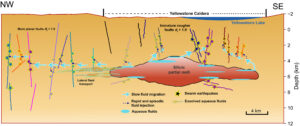
The Beaker Street Science Photography Prize has unveiled a stunning collection of images that delve into the microscopic world, offering a unique perspective on the hidden terrains of human health. Among the standout entries is a captivating photograph by Kelli Miller, which utilizes microscopy to reveal the intricate structures known as polymerised protein puddles (PPPs) found during a dried blood evaluation.
These PPPs, which appear as white areas resembling holes with black, tentacle-like lines extending from them, provide a deeper insight into an individual’s health. They range in size from small white dots to larger formations and are indicative of tissue health, often associated with free radical damage, oxidative stress, and the presence of toxins.
The Science Behind Polymerised Protein Puddles
Polymerised protein puddles are soft clots that form in the blood and are analyzed through advanced microscopy techniques. Their presence and size can offer critical insights into the body’s internal environment. According to medical experts, these formations are a sign of oxidative stress, a condition where the balance between free radicals and antioxidants in the body is disrupted, leading to potential cellular damage.
Dr. Emily Carter, a leading researcher in the field of oxidative stress, explains, “The formation of PPPs is a visual representation of the body’s struggle against oxidative damage. By examining these structures, we can assess the level of stress and potential harm within the body’s tissues.”
Implications for Health and Medicine
The discovery and analysis of PPPs have significant implications for both diagnostic and preventive medicine. By identifying the presence and extent of these formations, healthcare providers can better understand a patient’s exposure to oxidative stress and tailor interventions accordingly. This approach aligns with the growing trend towards personalized medicine, where treatments are customized based on individual health profiles.
Moreover, the ability to visualize these microscopic structures opens new avenues for research into the underlying causes of various diseases. As Dr. Carter notes, “Understanding the role of PPPs in disease progression could lead to breakthroughs in how we approach conditions linked to oxidative stress, such as cardiovascular diseases and certain types of cancer.”
Historical Context and Future Directions
The use of microscopy in medical diagnostics is not new; however, the focus on polymerised protein puddles represents a novel application of this technology. Historically, microscopy has been instrumental in the discovery of pathogens and the development of vaccines. The current exploration of PPPs continues this legacy, pushing the boundaries of what can be observed and understood at the microscopic level.
Looking forward, researchers are optimistic about the potential of further studies on PPPs to enhance our understanding of human health. As technology advances, the resolution and capabilities of microscopy are expected to improve, allowing for even more detailed examinations of these and other microscopic phenomena.
“The future of medicine lies in our ability to see and interpret the invisible,” says Dr. Carter. “As we continue to refine our techniques, the insights gained from studying polymerised protein puddles could transform our approach to health and disease.”
As the Beaker Street Science Photography Prize highlights the beauty and complexity of the microscopic world, it also underscores the importance of continued research and innovation in the field of medical science. The images serve as a reminder of the intricate connections between art and science, and the endless possibilities that lie within the unseen.
The exploration of polymerised protein puddles is just one example of how scientific photography can illuminate the mysteries of human health, offering both a visual feast and a catalyst for scientific discovery.






